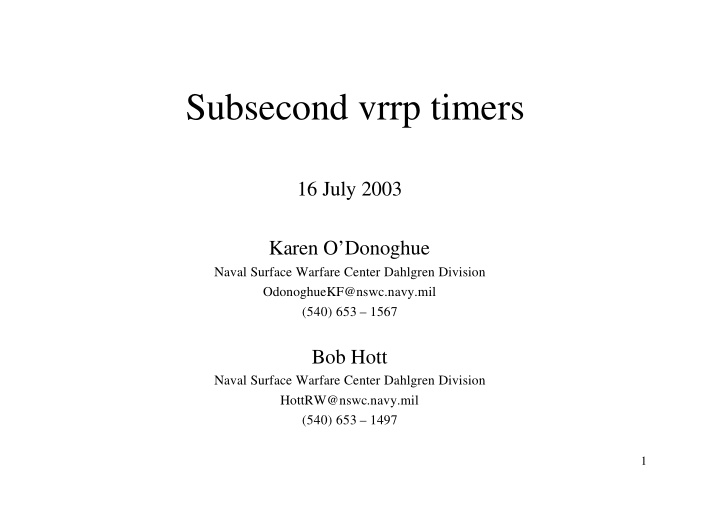



Subsecond vrrp timers 16 July 2003 Karen O’Donoghue Naval Surface Warfare Center Dahlgren Division OdonoghueKF@nswc.navy.mil (540) 653 – 1567 Bob Hott Naval Surface Warfare Center Dahlgren Division HottRW@nswc.navy.mil (540) 653 – 1497 1
Background • The shipboard environment has many of the same communications requirements that face commercial organizations – Support for voice, data, video and imaging, etc… – Security, Performance, Fault Tolerance (survivability) • But, there are a number of requirements beyond typical shore based networks… • Historically, each shipboard system would address its communications requirements in its own way, typically with built-to-spec systems and point-to-point links – Advantages: met initial requirements – Disadvantages: Scalability, technology refresh, cost ? 2
Architecture Evolution (Equipment) Federated Network-of-Networks SENSOR TRAIN- READI- COMMAND LINKS CORREL- COMMAND & CONTROL ING NESS LINKS ATION TO DISPLAY LAN ALL TRAIN- READI- LOW TO TO LATENCY ING NESS ANTI-AIR SYSTEMS ALL ALL MULTI- FUNCTION RADAR PATH HIGH BANDWIDTH SWITCH FABRIC S W S W S E E E E W ANTI-AIR SYSTEMS E N A N E A N A S P S P STRIKE SYSTEMS S ROUTER ROUTER P O O O O /BRIDGE /BRIDGE O O STRIKE SYSTEMS R R N R N N STRIKE LAN S S S S L L A UNDERSEA SYSTEMS UNDERSEA SYSTEMS A N N UWS LAN READINESS LAN Total Ship Computing Technical characteristics ANTI- COMMAND AIR – COTS-based open equipment S W – Fault tolerant, scaleable E E N A INTERCONNECT INTERCONNECT – Instrumental and verifiable S P FABRIC FABRIC O O – Uniform high throughput, low latency R N S SHIP SHIP S – Guaranteed quality of service CONTROL CONTROL – System-wide resource sharing STRIKE UNDERSEA – Dynamic resource allocation 3
Requirements Summary • The U.S. Navy needs to build shipboard networks that can provide: – End-to-end latencies of less than 200 microseconds – Scalable end-to-end throughput greater than 100 Mbps – End-to-end outage of less than 1 second due to a network fault (i.e., reconfiguration time includes the detection and recovery from the network fault) – The ability to interface with other open, commercial (COTS-based) networking solutions (e.g., routers, switches, encryption devices) 4
Current Navy Direction • Current direction for meeting our survivability requirements: – Dual homed end stations (Ramix proprietary solution) – HSRP with subsecond timers • We have done performance and functionality testing on HSRP/ESRP/VRRP. • We understand there are negative implications for subsecond timers (including instability and scalability), but we still feel these are useful in a certain subset of applications with an appropriate engineered network. 5
Possible vrrp approaches • We need the ability to use subsecond timers, and we would like this to be supported in a standard manner. • Possible approaches within vrrp specification – Add a flag (option) to indicate advertisement interval is in milliseconds instead of seconds • Carried in the vrrp frame • Configuration option (state machine clarification) – Modify the units of advertisement interval 6
Approach • Don’t have proposed text today (… my apologies) • What needs to be done (if you want to proceed)… – Decide on basic approach • Configuration option/state machine clarification (?) – Specification changes (preliminary impact review) • Advertisement_Interval • Master_Down_Timer • Adver_Timer – Add caveat/warning text about usage of this type of option – maybe followup with an information RFC with guidance for usage. • We are willing to provide this text in the near future if necessary. 7
• Thoughts… 8
Recommend
More recommend